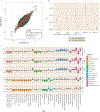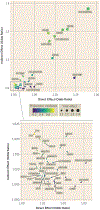Genetic Underpinnings of the Transition From Alcohol Consumption to Alcohol Use Disorder: Shared and Unique Genetic Architectures in a Cross-Ancestry Sample
- PMID: 37282553
- PMCID: PMC10731616
- DOI: 10.1176/appi.ajp.21090892
Genetic Underpinnings of the Transition From Alcohol Consumption to Alcohol Use Disorder: Shared and Unique Genetic Architectures in a Cross-Ancestry Sample
Abstract
Objective: Recent genome-wide association studies (GWASs) of alcohol-related phenotypes have uncovered key differences in the underlying genetic architectures of alcohol consumption and alcohol use disorder (AUD), with the two traits having opposite genetic correlations with psychiatric disorders. Understanding the genetic factors that underlie the transition from heavy drinking to AUD has important theoretical and clinical implications.
Methods: The authors used longitudinal data from the cross-ancestry Million Veteran Program sample to identify 1) novel loci associated with AUD and alcohol consumption (measured by the score on the consumption subscale of the Alcohol Use Disorders Identification Test [AUDIT-C]), 2) the impact of phenotypic variation on genetic discovery, and 3) genetic variants with direct effects on AUD that are not mediated through alcohol consumption.
Results: The authors identified 26 loci associated with AUD and 22 loci associated with AUDIT-C score, including ancestry-specific and novel loci. In secondary GWASs that excluded individuals who report abstinence, the authors identified seven additional loci for AUD and eight additional loci for AUDIT-C score. Although the heterogeneity of the abstinent group biases the GWAS findings, unique variance between alcohol consumption and disorder remained after the abstinent group was excluded. Finally, using mediation analysis, the authors identified a set of variants with effects on AUD that are not mediated through alcohol consumption.
Conclusions: Differences in genetic architecture between alcohol consumption and AUD are consistent with their having different biological contributions. Genetic variants with direct effects on AUD are potentially relevant to understanding the transition from heavy alcohol consumption to AUD and may be targets for translational prevention and treatment efforts.
Keywords: Alcohol; Genetics/Genomics; Substance-Related and Addictive Disorders.
Figures



Comment in
-
Alcohol Consumption and Alcohol Use Disorder: Exposing an Increasingly Shared Genetic Architecture.Am J Psychiatry. 2023 Aug 1;180(8):530-532. doi: 10.1176/appi.ajp.20230456. Am J Psychiatry. 2023. PMID: 37525606 Free PMC article. No abstract available.
References
-
- American Psychiatric Association: Diagnostic and Statistical Manual of Mental Disorders, 5th ed. Washington, DC, American Psychiatric Association, 2013
Publication types
MeSH terms
Grants and funding
LinkOut - more resources
Full Text Sources
Medical

